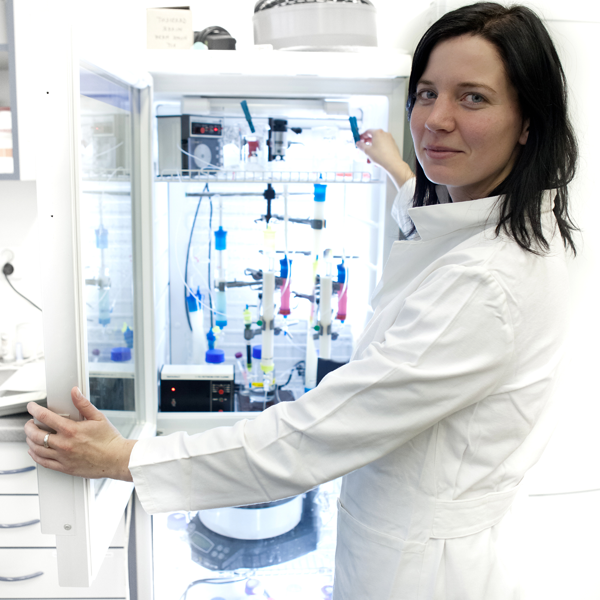We often refer to the instruments running protein purification techniques as the workhorses of the lab. Researchers rely on them to be up and running as standard. The great thing is that these instruments are actually quite simple to keep running well, as long as you follow some good housekeeping tips for sample preparation, buffer management, column cleaning and overall system cleanliness.
Protein purification systems such as GE’s AKTA or Bio-Rad NGC, are essentially a network of fine bore tubing and valves, with seals to prevent leaks. The worst enemy of any system is blocked tubing or valves, resulting in high back pressure or leaks and causing damage to valves and seals. The common potential problem areas are:
- Cross-contamination
- Bacterial growth
- Salt precipitation
To prevent cross-contamination and bacterial growth in the instrument, perform a System cleaning in place (System CIP) after each run.
Cut down on the salt!
Salts are really bad for your protein purification system. Salt precipitation can block valves and tubing and crystalline deposits can damage seals. The easiest way to avoid long-term exposure of system components to high salt concentrations and minimize the risk of salt precipitation is to flush your system with water after every run. When you have finished your runs for the day, its good practice to wash the whole system with degassed filtered water.
Be vigilant with your buffers
Good housekeeping with your buffers is another good way to prevent air and particulates from clogging up your system. We recommend these simple steps:
- Always degas and filter your buffers to minimize air and particulates in your mobile phase.
- Use inlet filters on all your lines.
- Keep an eye on buffer bottles for signs of bacterial growth – discard any solutions that appear cloudy on shaking or stirring.
- Use a bacteriostatic agent such as 0.02% sodium azide to prolong storage life.
For optimal results, use buffers, system and columns at ambient temperature during a protein purification run.
Keep your protein purification columns clean
- Centrifuge or filter your samples prior to loading, (unless you’re using a column designed specifically for crude samples).
- Remove any sample from the inlet tubing as soon as possible after each run.
- Clean your sample inlet lines and sample loops periodically with 1 M NaOH followed by water or neutralising buffer to eliminate sample build-up in tubing.
- Clean your columns regularly by reverse flow to remove any particulate matter stuck on top of the columns, and/or denaturants to dissolve insoluble proteins. Be sure to check the manufacturer’s guidelines for your column and follow their guidance on chemical compatibility and cleaning suggestions.
- Store columns correctly, refrigerated and with an appropriate bacteriostatic agent.
Give your system a wash
Perform a comprehensive system wash and cleaning regularly for optimal performance of the whole instrument, including your fraction collector. Most newer systems will have automated processes in-built, so you can run the manufacturer’s user-defined cleaning methods for the system. If not, a general cleaning recommendation is to flush the system once a week when it is in use, with 0.5 to 1 M NaOH. Start with flushing the pumps at a moderate flow rate and limit system exposure to harsh cleaning solutions to maximum 2 hours.
Put your protein purification system to bed clean!
If your system isn’t going to be used for a while (a couple of days or longer), make sure you run a comprehensive system wash and/or cleaning routine, as specified by the manufacturer. Then fill the system with the recommended storage solution (usually 20% ethanol) to minimize bacterial growth during storage.
How do I know I’ve got a problem?
On newer instruments, the pumps, detectors, and other components often each have a sensor and a reading, so your first stop should be to look at the manufacturer’s manual for the specific error codes. However, it is good practice to know your system to make sure you spot any potential problems quickly. The best things to focus on are the flow rate and the pressure. Pressure is often the first sign of system problems. Knowing your baseline pressure with or without the columns means you will soon spot if something goes off track during a run. Unusually high or low pressure can be caused by air bubbles, clogs, or salts. Flow rate is another good indicator of performance.
Simple checks and trouble-shooting:
- Make sure that the flow rate stated at the pumps is the one you actually observe at the outlet. If the pumps are saying 5 mls per minute, and you aren’t getting that at the outlet, then there are some leaks in the tubing and the connections, or something is clogging up the system.
- A jagged or sawtooth UV trace can indicate an air bubble trapped in the flow cell. Purging the system with 1M NaOH can often chase air out of the system.
- If the pressure is high, there might be clogs, like salt in the lines and in the connections or some air bubbles in the system. If there are air bubbles, then you need to purge the lines.
- Rule out a clogged column – if you try with a different column and the system pressure goes back to normal, then you know you’ll need to clean the original column.
Putting in a good housekeeping system that all the users in your lab follow should keep your chromatography system up and running. Complemented by a routine maintenance schedule, you can extend the life of your system and optimize your separations.
Check out our AKTA service packages and we’ll keep your system in top condition!

